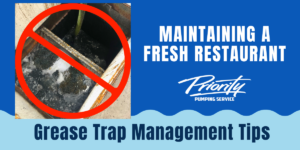The Intricacies of Seepage Pits: What You Need to Know
When exploring septic system solutions, homeowners often come across terms like “leach lines” and “seepage pits.” While leach lines are more commonly discussed, seepage pits are another vital part of the conversation. Today, we’re diving deep into the world of seepage pits for our readers and clients at Priority Pumping. Let’s explore what they are and when they’re used over traditional leach lines and the importance of understanding that seepage pits require a different soil testing procedure than traditional leach lines or chamber systems.
What is a Seepage Pit?
A seepage pit is a deep, vertically oriented excavation in the ground that receives effluent or partially treated wastewater from a septic tank. Its purpose is to allow this effluent to seep or percolate into the surrounding soil gradually.
The seepage pit or pits (the system flow may require there to be more than one pit) are connected to the outlet side of the septic tank with what is called a crossover sewer line. If there is more than one seepage pit, the crossover line will connect to a distribution box that will then connect to all of the pits servicing the system. The pits are required to have a 12’ separation, from edge to edge, from the other pits.
These pits are drilled with a large drill rig and measure between 4’-6’ in diameter and can be at depths of 50’+. Once the pits are drilled out, the hole is then filled with perforated sewer pipe and ¾” to 1 ½” wash aggregate rock ensuring the smooth transfer of wastewater into the surrounding area.
When to Consider Seepage Pit Installation Over Traditional Leach Lines?
There are specific scenarios where a seepage pit might be more favorable than leach lines:
**Space Constraints:** Seepage pits have a smaller horizontal footprint, making them ideal for properties with limited space.
**Usable Property Space:** Unlike traditional leach lines or chamber systems, seepage pits allow for more property space to be used for other things, such as swimming pools, exquisitely landscaped yards, driveways, courtyards, etc.

The Seepage Pit Installation Process
Installing a seepage pit involves several intricate steps:
**Site Evaluation:** First, an assessment of the site’s suitability for a seepage pit is carried out. This includes evaluating the soil type, water table levels, and available space.
**Seepage Performance Testing:** This crucial test determines the soil’s capacity to absorb and treat the effluent. It’s a specialized soil test that’s imperative for a successful seepage pit installation. This requires a test hole to be drilled in the area of the property where the system is being considered. The test hole is 18” in diameter and must be within 10’ of the desired depth of the seepage pit. To learn more about this entire process you can read about it here. The hole will be filled back in after testing.
It is so very important that this process is done properly and that seepage pits are not put in without a permit from County that thoroughly checks a variety of different things in order to preserve our environment and not endanger ground water quality. There is a great article from the EPS in April 2001 that explains why these illegal seepage pits can be catastrophic if not engineered and designed properly
**Digging:** Once the tests are completed, excavation begins. The depth and width of the pit depend on the amount of effluent expected and the soil’s absorption rate or you may hear us refer to it as the SAR. The seepage pit will not be drilled in the same place as the test hole, but nearby.
**Constructing the Pit:** As mentioned earlier, the pit is filled with perforated sewer line and aggregate rock to facilitate the dispersion of the wastewater.
**Connecting the Pit to the Septic Tank:** Once the pit is constructed, the pit is connected to the septic tank via the crossover line or the distribution box for multiple seepage pits.
How does a seepage pit work?
Once the septic tank is at the operating level, once one flush goes into the septic tank, that water amount (referred to as the effluent) will be pushed out the back of the septic tank to this seepage pit, where it will be filtered into the ground soil and treated before reaching the water table again. Cool huh! Mother Nature is so incredible.
While the seepage pit might not be the most talked-about part of septic systems, its importance cannot be underestimated. Whether you’re considering seepage pit installation or need expert guidance on seepage pit performance testing, trust the professionals at Priority Pumping. We’re here to ensure your septic solutions are efficient, safe, and tailored to your property’s needs.
Wanna see sewer line replacements in action? Check out our Instagram
Want to become a septic system guru? Check out our YouTube Channel
*For expert advice, seepage performance testing, and professional seepage pit installation services, reach out to Priority Pumping. Your property deserves the best, and we’re here to deliver!*













